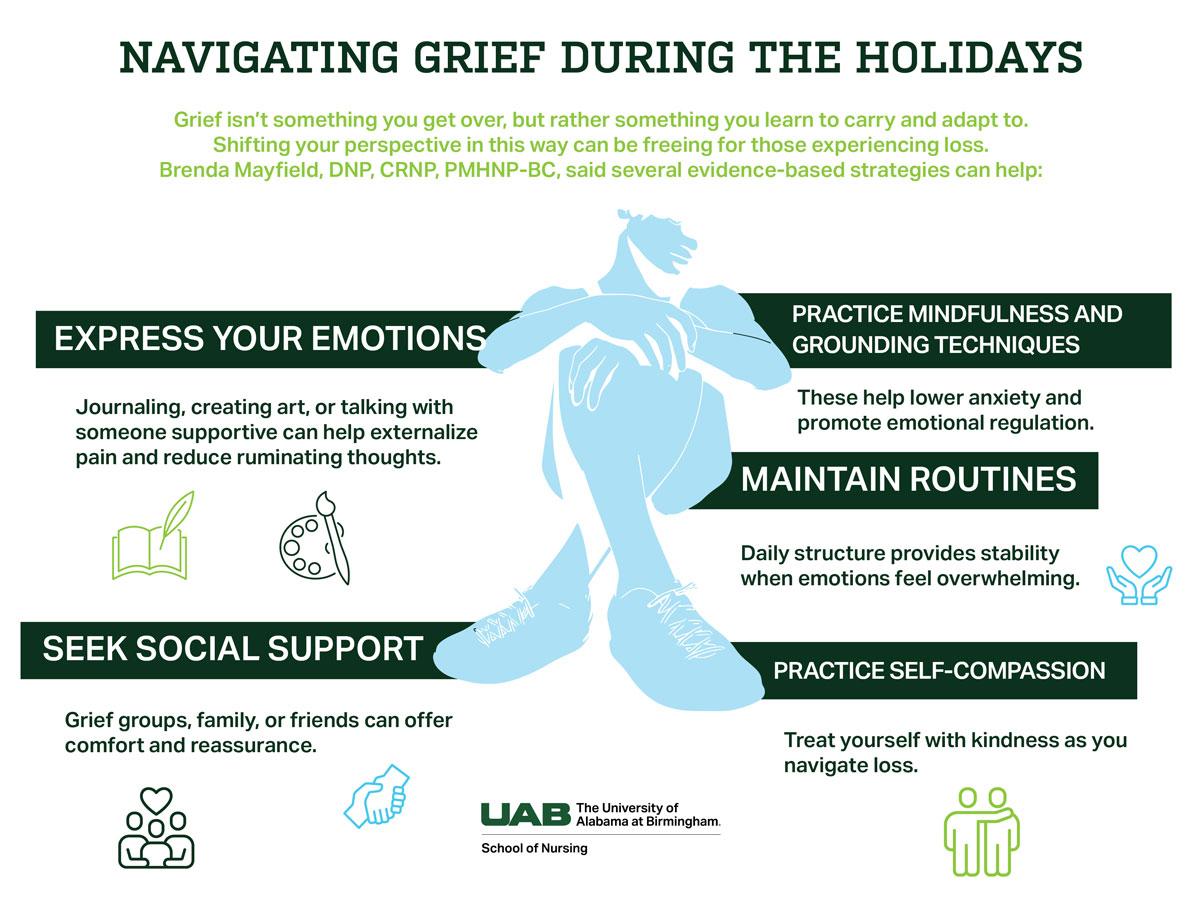
By Teresa Hicks
The holiday season is often filled with joy and celebration, but for those navigating loss, it can stir feelings of sadness and a reminder of what is missing.
Brenda Mayfield, DNP, CRNP, PMHNP-BC (MSN 2018, DNP 2022), Assistant Professor at the University of Alabama at Birmingham School of Nursing and co-coordinator of the Psychiatric/Mental Health Nurse Practitioner Specialty, shares insight from her clinical experience supporting patients navigating the emotional challenges of grief.
“Grief is not a problem to fix but a story to honor,” Mayfield said. “During the holidays, that story might feel heavier. But within it, there is love, memory and resilience.”
Understanding grief and its complexities can create space for experiencing both sorrow and celebration, which are essential to healing.
The nonlinear path of grief
Grief does not arrive politely or follow a straight path. It is recurring, unique to each person, and can manifest physically through fatigue, insomnia, appetite changes, irritability, or social withdrawal, according to Mayfield.
“I have heard the quiet confessions of patients who say, ‘I dread the holidays now,’ ‘I feel guilty for laughing and feeling joy or being excited,’ and ‘I just want to skip all of it,’” Mayfield said. “I personally understand that feeling when it seems a part of your heart is missing and how deeply that absence is felt.”
Many people believe grief has a predictable timeline. Thoughts like ‘I should be over this by now,’ ‘My family has moved on, why haven’t I?’ or ‘Why do I still feel like this?’ are common. Mayfield reminds her patients that healing doesn’t adhere to a calendar.
“Some wounds fade slowly, some more quickly, and others remain tender for years. All of these are okay,” Mayfield explained.
She said recognizing that these emotions and symptoms are part of the grieving process helps normalize the experience and reduces the stigma and shame that sometimes accompany loss.
When progress isn’t linear
Grief isn’t something you get over, but rather something you learn to carry and adapt to. Shifting your perspective in this way can be freeing for those experiencing loss. Mayfield said several evidence-based strategies can help:
- Express your emotions. Journaling, creating art, or talking with someone supportive can help externalize pain and reduce ruminating thoughts.
- Practice mindfulness and grounding techniques. This lowers anxiety and promotes emotional regulation.
- Maintain routines. Daily structure provides stability when emotions feel overwhelming.
- Seek social support. Grief groups, family, or friends can offer comfort and reassurance.
- Practice self-compassion. Treat yourself with kindness as you navigate loss.
Mayfield reminds us, “Sometimes healing feels like two steps forward and one step back. That is not regression; it’s part of the reality of grief.”
Recognizing complicated grief
Some individuals experience complicated or prolonged grief, marked by persistent yearning, emotional pain, and functional impairments lasting beyond 12 months.
“As a clinician, I look for patients experiencing intense longing, difficulty accepting the death, avoidance of reminders, social isolation, or impairments in work and relationships,” Mayfield said. “When grief becomes complicated or prolonged, seeking help from a mental health professional is essential.”
Several evidence-based treatments, such as cognitive behavioral therapy (CBT), complicated grief therapy (CGT), or trauma-informed approaches, can be highly effective, according to Mayfield. Early intervention is critical as untreated complex grief can increase the risk of depression, substance use, and suicidal thoughts.
Honoring loved ones while making space for joy
There is space to experience sorrow and joy simultaneously. Experiencing happiness does not diminish love or caring for someone who is no longer here. According to Mayfield, one of the most healing practices during the holidays is finding ways to honor loved ones while embracing conflicting emotions.
“My patients have shared meaningful rituals like lighting a candle in memory of a loved one, preparing their favorite meal, sharing stories and photos, volunteering, or writing letters to those who have passed,” Mayfield said. “These acts do not erase grief, but transform it into connection, allowing both remembrance and celebration to coexist.”
Nurses like Mayfield exemplify the School’s commitment to teaching and practicing compassionate care and mental health support, showing that grief is never faced alone—honoring loss and embracing support is one the vital role nurses have in guiding patients through some of life’s most challenging experiences.